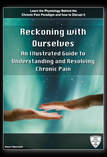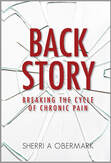Tension-Based Pain is a phrase I use to describe the type of pain that many people experience, taking many forms, and attacking different regions of the body. It seems to move, it change, and switches from the side to side, and back again. This multi-site assault can make us feel as though we are physically falling apart. What could explain all these different types of pains around the body for months or even years on end?
When I was introduced to the work of Dr. John Sarno, Professor of Rehabilitation Medicine, New York University School of Medicine, and attending physician at the Howard A. Rusk Institute of Rehabilitation Medicine, New York University Medical Center, and one of the most intuitive doctors that has ever practiced, in my opinion, I found my answer.
Dr. Sarno described a psychosomatic condition that he called Tension Myositis Syndrome (TMS), which is simply tension that contracts muscles, causing reduced blood flow, and subsequently a reduction of oxygen to the affected muscles
When tightened muscles constrict the arteries and veins in and around the muscles, it causes muscles to be starved of oxygen. The muscles and tissues are simply not profused well enough and when blood flow and oxygen are reduced they send a message of pain. Eventually, muscles starved of oxygen begin to spasm, and they will weaken and fail in time. When the muscles fail we may describe it as "throwing our back out". It's a sudden, severe pain, often occurring in the lower back, although it can occur anywhere in the body. The pain may feel so intense that we think we have a serious injury. Tension-Based Pain can manifest as low-back pain, neck pain, migraines, shoulder pain, tennis elbow, carpel tunnel syndrome, sciatica, tight calf muscles, plantar fasciitis, even IBS, Crohn's disease, Interstitial Cystitis and many other 'mysterious' physical afflictions.
Dr. Sarno described a psychosomatic condition that he called Tension Myositis Syndrome (TMS), which is simply tension that contracts muscles, causing reduced blood flow, and subsequently a reduction of oxygen to the affected muscles
When tightened muscles constrict the arteries and veins in and around the muscles, it causes muscles to be starved of oxygen. The muscles and tissues are simply not profused well enough and when blood flow and oxygen are reduced they send a message of pain. Eventually, muscles starved of oxygen begin to spasm, and they will weaken and fail in time. When the muscles fail we may describe it as "throwing our back out". It's a sudden, severe pain, often occurring in the lower back, although it can occur anywhere in the body. The pain may feel so intense that we think we have a serious injury. Tension-Based Pain can manifest as low-back pain, neck pain, migraines, shoulder pain, tennis elbow, carpel tunnel syndrome, sciatica, tight calf muscles, plantar fasciitis, even IBS, Crohn's disease, Interstitial Cystitis and many other 'mysterious' physical afflictions.
TENSION-BASED PAIN - Why does it happen?
Tension is a useful, naturally occurring function of the body, and there are many benefits of tension in the muscles, such as preparing for running, lifting something heavy, or other physical activity. It is a normal function, but in the case of Tension-Based Pain, we see muscles involuntarily tighten inappropriately, when there is no true danger. The autonomic nervous system senses a condition of being unsafe. Human beings may have pushed themselves further than their minds can handle day-to-day over the past 100 years and this constant state of stress causes underlying feeling of being at risk. The body's sympathetic nervous system reacts to this condition automatically by tightening muscles that ready the body to flee, but of course we aren't ready to run, we're may be in car, at our jobs, or even lying down to sleep.
Everyone goes through difficult times in life, grief at the loss of a loved one, illness for themselves, friends or family, financial issues, or other temporary or long-term stress. Managing these negative emotions, or using some type of therapy may be a good way to get us through these rough times. In the U.S. we spend an enormous amount of resources on treating issues in the body, but so little for our mind / psyche, which is where many of our physical issues arise.
Tension-Based Pain can be startling, painful, and frightening when we suddenly experience it, but thankfully we have many tools at our disposal to manage and overcome it. In my experience, I found that I could reduce my physical tension and the emotions that caused it. You can change your life, you can start today!
Wishing you every success in living a life free of Tension-Based Pain.



